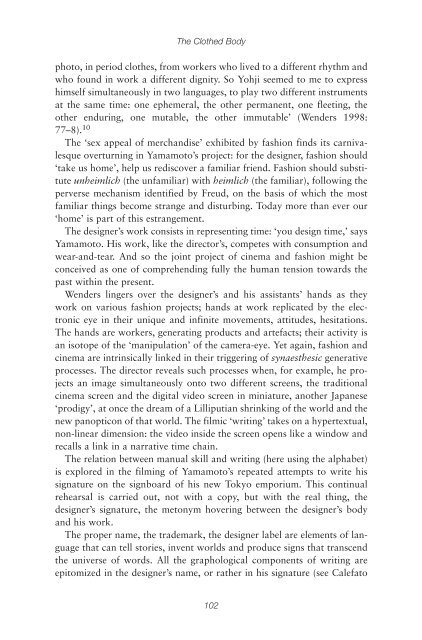Create successful ePaper yourself
Turn your PDF publications into a flip-book with our unique Google optimized e-Paper software.
<strong>The</strong> <strong>Clothed</strong> <strong>Body</strong><br />
photo, in period clothes, from workers who lived to a different rhythm and<br />
who found in work a different dignity. So Yohji seemed to me to express<br />
himself simultaneously in two languages, to play two different instruments<br />
at the same time: one ephemeral, the other permanent, one fleeting, the<br />
other enduring, one mutable, the other immutable’ (Wenders 1998:<br />
77–8). 10<br />
<strong>The</strong> ‘sex appeal of merchandise’ exhibited by fashion finds its carnivalesque<br />
overturning in Yamamoto’s project: for the designer, fashion should<br />
‘take us home’, help us rediscover a familiar friend. Fashion should substitute<br />
unheimlich (the unfamiliar) with heimlich (the familiar), following the<br />
perverse mechanism identified by Freud, on the basis of which the most<br />
familiar things become strange and disturbing. Today more than ever our<br />
‘home’ is part of this estrangement.<br />
<strong>The</strong> designer’s work consists in representing time: ‘you design time,’ says<br />
Yamamoto. His work, like the director’s, competes with consumption and<br />
wear-and-tear. And so the joint project of cinema and fashion might be<br />
conceived as one of comprehending fully the human tension towards the<br />
past within the present.<br />
Wenders lingers over the designer’s and his assistants’ hands as they<br />
work on various fashion projects; hands at work replicated by the electronic<br />
eye in their unique and infinite movements, attitudes, hesitations.<br />
<strong>The</strong> hands are workers, generating products and artefacts; their activity is<br />
an isotope of the ‘manipulation’ of the camera-eye. Yet again, fashion and<br />
cinema are intrinsically linked in their triggering of synaesthesic generative<br />
processes. <strong>The</strong> director reveals such processes when, for example, he projects<br />
an image simultaneously onto two different screens, the traditional<br />
cinema screen and the digital video screen in miniature, another Japanese<br />
‘prodigy’, at once the dream of a Lilliputian shrinking of the world and the<br />
new panopticon of that world. <strong>The</strong> filmic ‘writing’ takes on a hypertextual,<br />
non-linear dimension: the video inside the screen opens like a window and<br />
recalls a link in a narrative time chain.<br />
<strong>The</strong> relation between manual skill and writing (here using the alphabet)<br />
is explored in the filming of Yamamoto’s repeated attempts to write his<br />
signature on the signboard of his new Tokyo emporium. This continual<br />
rehearsal is carried out, not with a copy, but with the real thing, the<br />
designer’s signature, the metonym hovering between the designer’s body<br />
and his work.<br />
<strong>The</strong> proper name, the trademark, the designer label are elements of language<br />
that can tell stories, invent worlds and produce signs that transcend<br />
the universe of words. All the graphological components of writing are<br />
epitomized in the designer’s name, or rather in his signature (see Calefato<br />
102

















